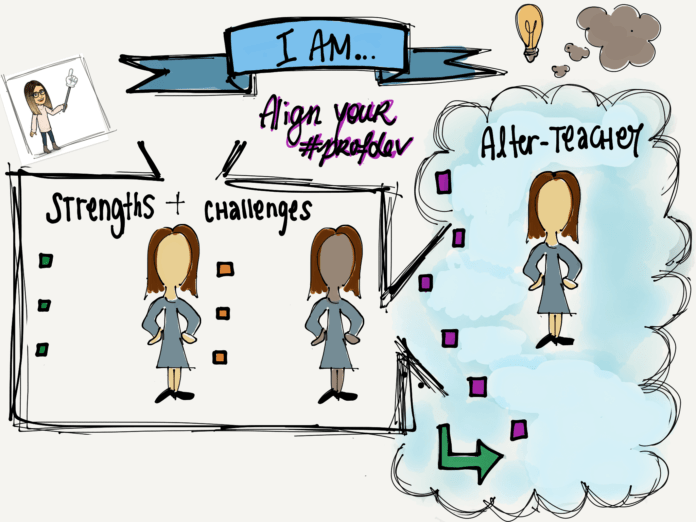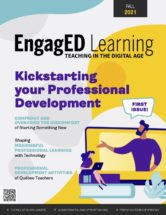This article is part of
Vol. 1, issue 1 (Fall 2021)
of EngagED Learning magazine.
For some time now, there’s been an explosion in the amount of continuous education activities for teachers. They can engage in a rich and thoughtful professional development process, in line with their school team’s project, or they can seek additional knowledge in a more personal, ad-hoc way, by attending webinars, workshops and conventions, listening to podcasts, doing professional reading, etc.
Even within a united team, each teacher is unique, and has their own way of seeing their class and, above all, their way of envisioning it, of guiding it. In order to meet your personal and professional aspirations, it’s important to stop, think and take time ”to align your #profdev”. Consistency is indeed a recognized feature of effective professional development, as explained in the article on page 4.
To follow the proposed process, refer to the professional development journal available here: https://monurl.ca/profdevjournal
#ProfDev
In the world of social networks, especially on Twitter and Instagram, the “#” symbol, commonly-known as a hashtag, is used to create links between content and conversations about common topics. The #ProfDev hashtag, for example, refers to publications dealing with professional development in education.
Here’s a reflection process that can support those who wish to better structure their professional development.
1 – Choose your goal
In order to undertake an approach that suits you, first think about one of your primary goals and the “why” behind that goal.
A primary goal is an overview of the direction your professional development journey will take. For example, it can take a very vague form, like “develop my digital skills”, or “learn to use my iPad in the classroom”. The goal can also be more specific, such as “integrate a digital portfolio into the classroom with my students” or “involve my students into the assessment process”.
Once you’ve set a goal, think about its “why”. Is it because you want to take up a new challenge? To better engage your students? To integrate a new project in your school? An approach that comes from within you or that you fully embrace makes it easier to move forward in the process and to maintain the necessary motivation.
2- Create your vision
With the main goal identified, let’s see what you already have in your toolbox, what you need to add to it, and what it will look like next.
a- Identify your strengths:
Identify three things that you master and are proud of, and that relate to your goal. It can be an educational attitude (flexibility, open-mindedness, differentiation), knowledge of applications useful for your project (Classroom, Flipgrid, etc.) or even an achievement (setting up a program, tutoring, etc.). The red character in the journal represents your acquired skills.
b- Identify your challenges:
Now identify three things that you want to develop further in relation to your goal: what would you like to learn to continue on your path? In the same way as in the previous step, you can target both mastery of applications and a change in your concept of evaluation, for example. The green character represents what needs to be developed; your challenges.
c- Create your alter-teacher:
The question is easy to ask, but it is often difficult to answer: Who will I become after all this? To accomplish this, take your challenges from Step 2 and turn them into accomplishments. For example, “I would like to be more flexible in choosing which applications students use” will turn into something like “my students can choose the right application for them for each of the projects to be completed.” Then add your strengths and you will get an alter-ego, a character who represents all your skills once your #profdev journey has begun and is well underway.
At the end of the exercise, you may have a result similar to this one:

The goal of this process is to chart a course that resembles you, even if it must be located within a group or institutional project. It avoids having all the members of a crew on the same boat when each one does not have the same role and, even more importantly, the same aptitudes and the same motivations. Here it is YOUR goal, YOUR tools and YOUR success.
3- Find relevant resources
Before discussing the resources that may be relevant to achieving your goal, it is important to remember that professional development can take several paths. So how do you navigate it? By simply choosing the resources that best meet your needs. The marvelous thing is that you’ve already identified these needs in steps 1 and 2. You now know what to focus on, without spreading yourself too thin.
Always keep your main goal in mind. Since there are several resources, it might be easy to get lost. If you waste your time unnecessarily, you risk not reaching your target.
Here are some inspiring ideas.
Ditch that textbook
This website is operated by Matt Miller, one of the top 10 education influencers. You’ll find lots of teaching tips, articles, books, videos, and more on this website. In his own classes, he found that textbooks were more of an obstacle to learning than a help, so he ditched them. Are you curious about how you could do that too? Here’s a good place to start.
The Teach 100
https://teach.com/what/teachers-know/teach100/
If you’re looking for inspirational education blogs to boost your teaching, here’s a list of over 900 of them, ranked according to a score calculated to highlight the most influential and transformative blogs on the web.
Sylvia Duckworth
Sylvia Duckworth is a Toronto-based teacher with more than 30 years of experience. She has become a leader in sketchnote, a visual note-taking strategy. Beyond that, she seems to have it all, so check out her website to get lots of inspiration for your professional development goals.
House of #Edtech podcast
This podcast explores how education technology is changing the way teachers teach. It was recognized as the best educational podcast of 2021 by the Education Podcast Network, so it might be worth listening to!
Learn Québec
LEARN’s Pedagogical Services Team develops and shares resources and provides professional learning opportunities for educators in the English language community, online and on-site.
Twitter is a never-ending source of professional development opportunities in education. Here are a few people to follow: You can also follow @LainieRowell, @burgessdave, and @HollyClarkEdu. Oh, and of course, don’t forget to follow us at @EngagEDLearnMag and @ecolebranchee (in French).
Beyond the avenues suggested above, which are outside the school walls, don’t forget the resources available to you in your own work environment. These include educational advisors, your colleagues, your directors, and anyone around you who is a source of inspiration. Don’t hesitate to question and observe, as this can only give you energy for your #ProfDev.
4- Schedule your #ProfDev
Now that you have a clearer picture of what you want to become (your alter-teacher) and what can help you achieve your goals through the resources identified, it’s time to get it all organized. A good way to do this is to schedule time in your schedule for professional development activities, through a monthly game plan over a year-long period. Basically, this means setting aside time to listen to a podcast, put training courses that interest you into your agenda, make your requests to management and the professional development committee to attend a convention, etc. Give yourself realistic targets according to your reality, and don’t rule out the possibility of changing your plan during the year.
And why not sign your plan! It’s like a contract with yourself. By developing your own tailor-made professional development path, you’ll give yourself every chance for success. All you have to do is follow your path!
5- Take stock
The step of taking stock is too often overlooked. But it’s just as important as planning. It enables us to take a look at how far we’ve come. In the heat of the moment and in everyday life, we don’t always realize what we’ve learned.
Did you accomplish your goal, or has your path taken an entirely new direction ? If you veered off your initial path, was it intentional? Did that keep you moving forward anyway? What did you like? What were your challenges? What would you change next? Are there any measurable findings in your practice? And above all, how are you doing? Do you feel like you’ve accomplished something for yourself?
Perhaps the most important part of this review is the last question: What am I going to do now? The journey isn’t over; the process can be restarted from the beginning or even continued according to your new objectives. There’s no reason to stop – professional development in education is a lifelong experience.
Tips to help you better follow your plan
Develop your professional network
You should never underestimate the strength of a network. In this age of social networks, it’s easier than ever to surround yourself with colleagues (and not just those from your own school) who share the same interests and goals as you, who want to move forward and develop themselves. This gives you wings and energy.
Register in advance for activities
If you’d like to participate in training, a webinar, or even a university course, please register as soon as the opportunity arises. Otherwise, it’s easy to postpone it, only to forget and…lose sight of your goal.
Always keep your intention in mind, your “why”
As in any long-term project, there are times when the motivation just isn’t there and you want to give up your will to continue. At this point, think about what first prompted you to begin your process: the “why”. Was it for your students? For your love of the best job in the world? To develop new skills? To be able to complete a specific project? This “why” must always be top of mind in order to maintain the necessary momentum.
The power of social media
The reputation of social networks like Twitter, Facebook or LinkedIn in the workplace needs no introduction. These platforms provide access to inspiring people, relevant publications and thoughts that are essential for professional development.
These networks help you connect with colleagues from all over the world and collaborate with people with whom it would otherwise be unthinkable.
If you don’t yet have a Twitter account, for example, now is the time to set one up and connect with your main influencers in education. And why not start by following activity related to the #ProfDev hashtag?




